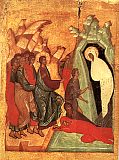

| Previous day | Next day |
| Old Style
April 3
|
Saturday |
New Style
April 16
|
|
Sixth Week of Great Lent (Palm Week). Lazarus Saturday.
Tone 1.
Great Lent. Caviar, wine and oil allowed. |
Caviar, wine and oil allowed.
|
![]() Lazarus Saturday
Lazarus Saturday ![]() St. Nicetas the Confessor, abbot, of Medikion (824).
St. Nicetas the Confessor, abbot, of Medikion (824).
Martyrs Elpidephorus, Dius, Bithonius, and Galycus (3rd c.). Virgin-martyr Theodosia of Tyre (307-308). St. Illyrius, monk of Mt. Myrsinon in the Peloponnese. St. Philip I, metropolitan of Moscow (1473). St. Nectarius, founder of Bezhetsk Monastery (Tver) (1492).
Icons of the Most Holy Theotokos “The Unfading Flower” and Iveron.
Martyrs Cassius, Philip, and Eutychius, of Thessalonica (304). Martyr Ulphianus of Tyre (306). Martyrs Evagrius, Benignus, Chrestus, Arestus, Kinnudius, Rufus, Patricius, and Zosima, at Tomis in Moesia (ca. 310). St. Fara (Burgundofara) of Eboriac (now Faremoutiers) (7th c.). St. Joseph the Hymnographer, of Sicily (883). New Martyr Paul the Russian, at Constantinople (1683). St. Amphilochius (Makris), elder, of Patmos (1970).
Thoughts for Each Day of the Year
According to the Daily Church Readings from the Word of God
By St. Theophan the Recluse

Saturday. [Heb. 12:28–13:8; John 11:1–45]
To whomever has work-loving Martha, who symbolizes comprehensive good works, and who has Mary sitting at Jesus’ feet, symbolizing an attentive and warm appeal to the Lord with all the heart, the Lord Himself will come and will resurrect Lazarus, who symbolizes his spirit, and will release him from all his emotional and fleshly bonds. Then a truly new life will begin in him, bodiless in the body and unearthly on the earth. It will be a true resurrection in the spirit before the future resurrection, which will be together with the body!
Articles
 Venerable Nicetas the Confessor the Abbot of MedikionSaint Nicetas the Confessor was born in Bithynian Caesarea (northwest Asia Minor) of a pious family. |
 Martyrs Elpidephorus, Dius, Bithonius, and GalycusThe Holy Martyrs Elpidephorus, Dius, Bithonius, and Galycus suffered for their faith in Jesus Christ. |
 St. Illyricus the Monk of Mt. Myrsinon in the PeloponnesusSaint Illyricus the Wonderworker devoted himself to ascetic struggles on Mount Myrsinon in the Peloponnesus. |
 Icon of the Mother of God “the Unfading Bloom”On this icon the Most Holy Theotokos holds Her Divine Son upon Her right arm, and in Her left hand is a bouquet of white lilies. |


